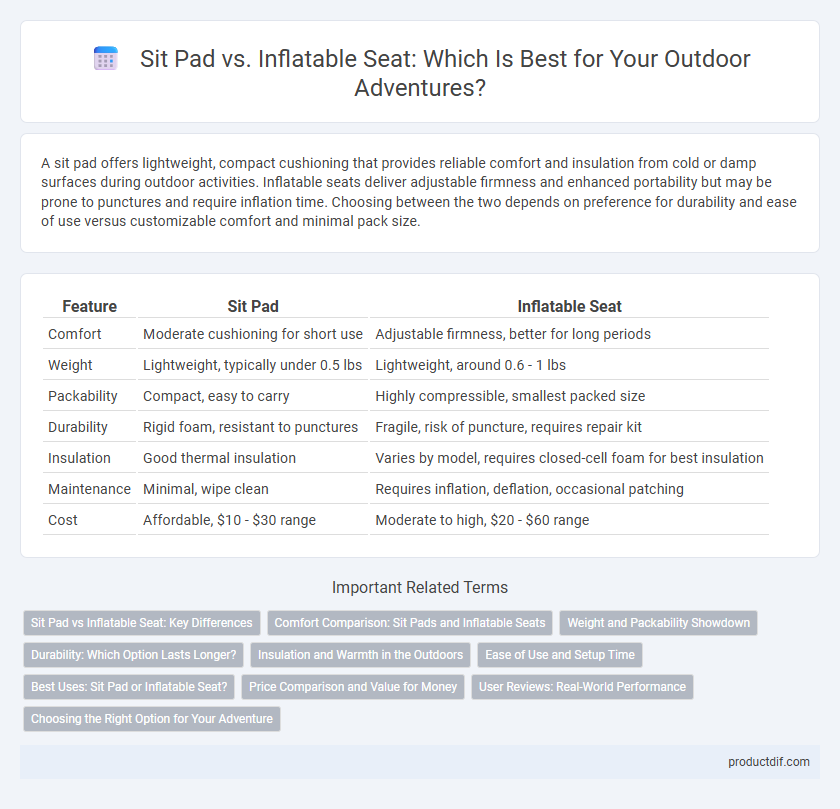A sit pad offers lightweight, compact cushioning that provides reliable comfort and insulation from cold or damp surfaces during outdoor activities. Inflatable seats deliver adjustable firmness and enhanced portability but may be prone to punctures and require inflation time. Choosing between the two depends on preference for durability and ease of use versus customizable comfort and minimal pack size.
Table of Comparison
| Feature | Sit Pad | Inflatable Seat |
|---|---|---|
| Comfort | Moderate cushioning for short use | Adjustable firmness, better for long periods |
| Weight | Lightweight, typically under 0.5 lbs | Lightweight, around 0.6 - 1 lbs |
| Packability | Compact, easy to carry | Highly compressible, smallest packed size |
| Durability | Rigid foam, resistant to punctures | Fragile, risk of puncture, requires repair kit |
| Insulation | Good thermal insulation | Varies by model, requires closed-cell foam for best insulation |
| Maintenance | Minimal, wipe clean | Requires inflation, deflation, occasional patching |
| Cost | Affordable, $10 - $30 range | Moderate to high, $20 - $60 range |
Sit Pad vs Inflatable Seat: Key Differences
Sit pads offer compact, lightweight cushioning made from foam or dense materials, ideal for quick breaks on rough terrain. Inflatable seats provide adjustable comfort by allowing users to control firmness, often including features like backrests or integrated storage pockets. Key differences include durability, ease of cleaning, insulation properties, and overall packability, influencing user preference based on outdoor activity needs.
Comfort Comparison: Sit Pads and Inflatable Seats
Sit pads offer firm, consistent cushioning ideal for short breaks and rugged terrain, providing reliable support without added bulk. Inflatable seats excel in adjustable comfort, allowing users to customize firmness and often featuring ergonomic designs that reduce pressure points during extended outdoor activities. Both options prioritize portability, but inflatable seats typically deliver superior cushioning for prolonged seating comfort in diverse outdoor environments.
Weight and Packability Showdown
Sit pads offer ultralight weight, often under 4 ounces, making them ideal for minimalist hikers focused on reducing pack load. Inflatable seats weigh more, generally between 6 to 10 ounces, but pack down smaller than most sit pads, enhancing compactness for tight storage spaces. Choosing between the two depends on prioritizing either minimal weight or maximum compressibility in outdoor gear setups.
Durability: Which Option Lasts Longer?
Sit pads typically offer superior durability due to their solid foam construction, resisting punctures and wear over extended outdoor use. Inflatable seats, while providing superior comfort and compactness, are more prone to leaks and damage from sharp objects, often requiring frequent repairs or replacements. For long-term reliability in rugged environments, sit pads remain the preferred choice among outdoor enthusiasts.
Insulation and Warmth in the Outdoors
Sit pads provide consistent insulation by using closed-cell foam that retains body heat and blocks cold ground, making them reliable in freezing conditions. Inflatable seats, while compact and lightweight, may trap less heat and can develop leaks that compromise their insulation effectiveness. Choosing a sit pad ensures better warmth retention and comfort during extended outdoor activities in cold environments.
Ease of Use and Setup Time
Sit pads provide instant comfort with minimal setup, requiring only placement on the ground, making them ideal for quick breaks during hikes. Inflatable seats offer adjustable cushioning but demand extra time and effort for inflation and deflation, which can be cumbersome in cold or windy conditions. For simplicity and speed, sit pads are preferable, while inflatable seats are better suited for longer rest periods needing customizable support.
Best Uses: Sit Pad or Inflatable Seat?
Sit pads provide durable, lightweight comfort ideal for short breaks during hiking or climbing, offering essential insulation and moisture resistance. Inflatable seats excel in camping and extended outdoor events, delivering customizable cushioning and compact storage for prolonged sitting. Choosing between a sit pad or inflatable seat depends on prioritizing portability and simplicity versus enhanced comfort and adjustability.
Price Comparison and Value for Money
Sit pads typically cost between $15 and $40, offering a durable and low-maintenance option ideal for budget-conscious outdoor enthusiasts. Inflatable seats range from $25 to $70, providing superior comfort and compact portability but requiring more care and occasional repairs. Considering price versus value, sit pads present a cost-effective solution for reliability, while inflatable seats justify higher prices with enhanced cushioning and versatility.
User Reviews: Real-World Performance
User reviews highlight that sit pads offer consistent comfort and durability across various terrains, especially appreciated for extended hikes and rough ground. Inflatable seats receive praise for their lightweight design and compact packability, although some users report occasional punctures or air leaks reducing reliability. Overall, outdoor enthusiasts balance comfort and convenience by selecting sit pads for rugged stability and inflatable seats for ultralight portability.
Choosing the Right Option for Your Adventure
Sit pads offer lightweight durability and insulation ideal for rugged terrains and cold weather hiking, while inflatable seats prioritize comfort and compactness for extended rest periods and versatile outdoor activities. Considering the adventure type, duration, and weather conditions helps determine the best choice; sit pads are perfect for short, rustic hikes requiring minimal packing, whereas inflatable seats excel in providing cushioned support during long stays or camping trips. Evaluating factors like weight, insulation, comfort, and portability ensures the gear matches the specific needs of your outdoor experience.
Sit Pad vs Inflatable Seat Infographic

 productdif.com
productdif.com